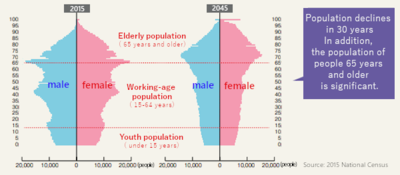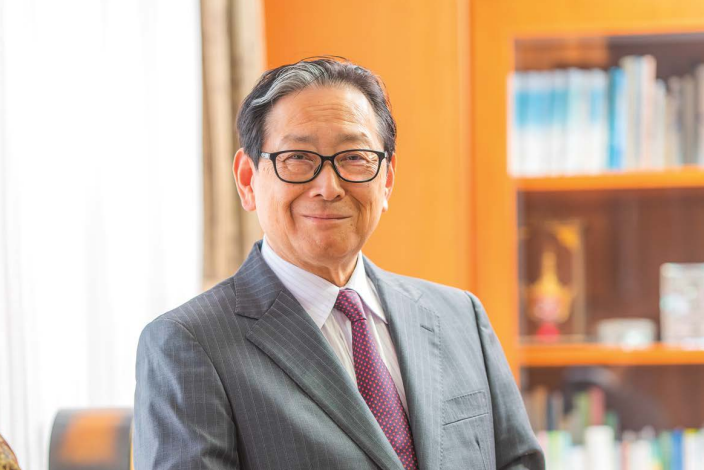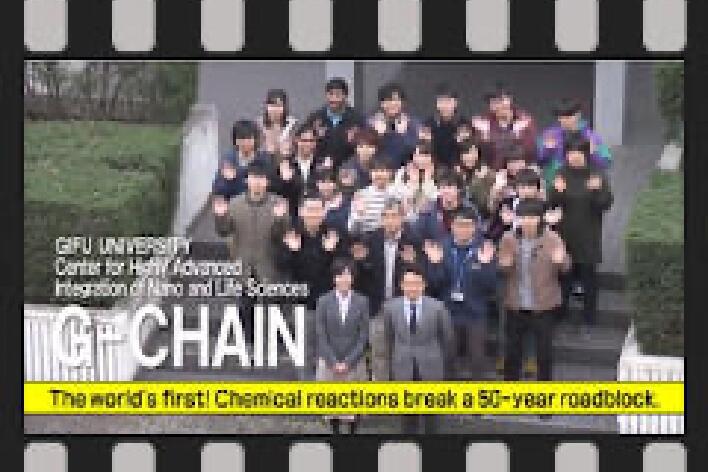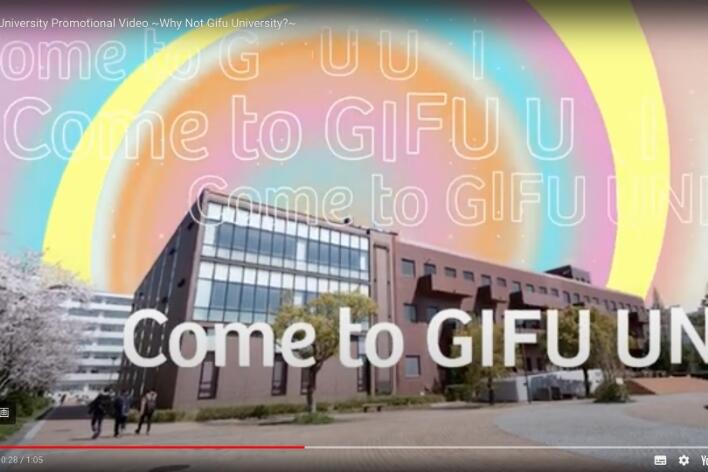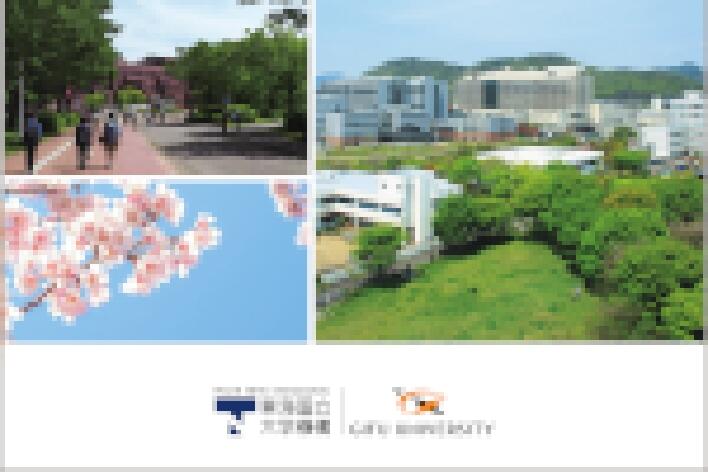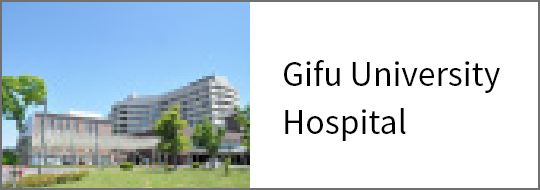Regional Adaptation Research Center, Institute for Advanced Study Gifu University
*Information related to faculty members/students and graduate schools at Gifu University here are all that of the time of interviewing.
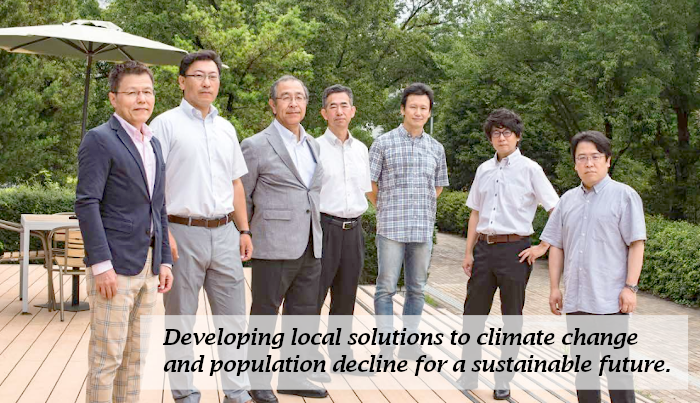
Mission of the Regional Adaptation Research Center

As global warming and population decline continue, the balance of the natural environment will be upset, and lifestyles and traditions will be affected. To adapt to these changes in the social environment, we will integrate the research methods and knowledge of six divisions of the center and develop a method for comprehensive evaluation from a regional perspective. Furthermore, we will promote the development of research that allows for the adaptation to natural disasters and climate change by collaborating with local communities and governments.
Director
Associate Professor Morihiro Harada
Regional Adaptation Research Center(River Basin Research Center, Gifu University)
Six divisions collaborate to study adaptation measures to climate change and population decline.
- Communities will protect human lives and resist damage to properties, even during periods of heavy rain and major typhoons.
- Even if children leave their hometowns, they will eventually return and ensure that their communities thrive.
- A variety of people, and not just river management departments and fishing cooperatives, will take action to protect the environment of each river.
- Each river will be protected, and its environment and biodiversity will be preserved.
| Division Head,Division of Regional Collaboration Specially Appointed Professor Shuichi Nonomura  Research on social implementation methods / Collaboration with government agencies Contact point / Examination of methods for collaboration with other research departments Research on social implementation methods / Collaboration with government agencies Contact point / Examination of methods for collaboration with other research departments |
Division Head,Division of Water Environments Associate Professor Takeo Onishi  (Faculty of Applied Biological Sciences, Gifu University) (Faculty of Applied Biological Sciences, Gifu University)Assessment of global warming impacts on water resources and material dynamics / Impacts on rivers/agricultural ecosystems, fishery species, and study of adaptation measures |
| Division Head,Division of Social Systems Professor Akiyoshi Takagi  (Department of Civil Engineering, Faculty of Engineering, Gifu University) (Department of Civil Engineering, Faculty of Engineering, Gifu University)Impacts of climate change/population decline on local economies and communities and study of adaptation measures |
Division Head,Division of Agricultural Adaptation Professor Tsutomu Matsui  (Faculty of Applied Biological Sciences, Gifu University) (Faculty of Applied Biological Sciences, Gifu University)Climate change impact on major agricultural products in Gifu Prefecture / Shifting crops / breeding as part of climate change adaptation measures |
| Division Head,Division of Forest Ecosystem and Resources Professor Hiroyuki Muraoka  (River Basin Research Center, Gifu University) (River Basin Research Center, Gifu University)Greenhouse gas absorption capacity of forests and prediction of change / Study on adaptation measures in the field of forest management/forestry |
Division Head,Division of Regional Climate Change Associate Professor Jun Yoshino  (Department of Civil Engineering, Faculty of Engineering, Gifu University) (Department of Civil Engineering, Faculty of Engineering, Gifu University) Regional climate change impacts based on climate change projections / Future projections of extreme weather phenomena such as typhoons/heavy rains/droughts |
Establishment of a new organization that tackles the collective issues of climate change and population decline.
 HARADA : At GIFU UNIVERSITY, even prior to the establishment of the Regional Adaptation Research Center in February 2020, we have been working with Gifu Prefecture on the Social Implementation Program on Climate Change Adaptation Technology (SI-CAT). SI-CAT is a research project that was initiated to predict the impact of climate change on the region and to study how to prepare for such a change. When SI-CAT was launched in 2015, few people were familiar with global warming. However, in the past few years, the social landscape has changed as weather phenomena have become even more extreme, and there have been several torrential rain disasters across the country. Increasingly more people are now aware that the effects of global warming are creeping up around us.
HARADA : At GIFU UNIVERSITY, even prior to the establishment of the Regional Adaptation Research Center in February 2020, we have been working with Gifu Prefecture on the Social Implementation Program on Climate Change Adaptation Technology (SI-CAT). SI-CAT is a research project that was initiated to predict the impact of climate change on the region and to study how to prepare for such a change. When SI-CAT was launched in 2015, few people were familiar with global warming. However, in the past few years, the social landscape has changed as weather phenomena have become even more extreme, and there have been several torrential rain disasters across the country. Increasingly more people are now aware that the effects of global warming are creeping up around us.
While SI-CAT has focused on climate change preparedness, Gifu University has maintained a strong awareness of the population decline issue. Gifu Prefecture, which is home to several intermediate and mountainous regions, is experiencing rapid depopulation. If we do not prepare for the double whammy of global warming and population decline immediately, we will not be able to sustain life as we know it. It is with this strong sense of crisis that we have continued our efforts.
Throughout the five years of SI-CAT activities, we have developed strong relationships of trust with the prefectural government officials, networked with researchers throughout Japan, and created a new community within Gifu University that transcends organizational boundaries. Although the SI-CAT project ended in FY2019, the Gifu Prefectural Government requested that we continue our support with respect to adapting to future climate change, and the center was established as a place to outline a "vision for the future of the region," utilizing previous results from the project to address not only climate change but also population decline.
One of the greatest strengths of the Regional Adaptation Research Center is that the world's top researchers are gathered on a single campus at Gifu University. This allows each researcher at the center to work closely together to conduct research in a comprehensive manner. In addition to having experts who can connect meteorology to discussions on site, which is rare for a regional university, Gifu University has long been home to the River Basin Research Center, which realizes the sustainable use of natural resources and has established strong collaborative relationships among researchers studying forests, water, and soil. Furthermore, we have experts in the field of agriculture, for which there is a strong need from the local community, as well as experts knowledgeable on social systems, which is essential when discussing population decline. We have established an incredibly comprehensive research system thanks to the numerous excellent researchers who have come together through the efforts of SI-CAT.
The following six departments collaborate to explore what the region should look like.
 MURAOKA : The Division of Forest Ecosystem and Resources, of which I am the head, focuses on forests and their ability to absorb greenhouse gases such as carbon dioxide, which have an impact on global warming. This division also focuses on the prediction of changes in this capacity, as well as the study of adaptation measures in the fields of forest management and forestry. Forests, which cover more than 80% of Gifu Prefecture, are beneficial in that they provide a variety of functions called "ecosystem services," including the generation of reusable organic resources, such as timber, and the control of rainwater. However, because of global warming, the forests in Gifu Prefecture are beginning to be significantly affected. A typical example is the shift in the timing of cherry blossoms and autumnal leaves. To adapt to the effects of climate change, we would like to provide Gifu Prefecture with information that will contribute to research on climate change while simultaneously considering measures based on scientific findings. Additionally, we plan to hold lectures at schools as part of our effort to educate the local community.
MURAOKA : The Division of Forest Ecosystem and Resources, of which I am the head, focuses on forests and their ability to absorb greenhouse gases such as carbon dioxide, which have an impact on global warming. This division also focuses on the prediction of changes in this capacity, as well as the study of adaptation measures in the fields of forest management and forestry. Forests, which cover more than 80% of Gifu Prefecture, are beneficial in that they provide a variety of functions called "ecosystem services," including the generation of reusable organic resources, such as timber, and the control of rainwater. However, because of global warming, the forests in Gifu Prefecture are beginning to be significantly affected. A typical example is the shift in the timing of cherry blossoms and autumnal leaves. To adapt to the effects of climate change, we would like to provide Gifu Prefecture with information that will contribute to research on climate change while simultaneously considering measures based on scientific findings. Additionally, we plan to hold lectures at schools as part of our effort to educate the local community.
 TAKAGI : Disasters are not created by natural phenomena alone but in conjunction with social phenomena. For example, a landslide is not a disaster if it occurs on an uninhabited island. It is only when the landslide destroys buildings or kills and injures humans that it becomes a disaster. With respect to climate change, it is important to consider how we live our lives. Therefore, in the social systems research division, we are considering adaptation measures from the perspective of social systems in terms of the impacts of climate change and population decline on local economies and communities.
TAKAGI : Disasters are not created by natural phenomena alone but in conjunction with social phenomena. For example, a landslide is not a disaster if it occurs on an uninhabited island. It is only when the landslide destroys buildings or kills and injures humans that it becomes a disaster. With respect to climate change, it is important to consider how we live our lives. Therefore, in the social systems research division, we are considering adaptation measures from the perspective of social systems in terms of the impacts of climate change and population decline on local economies and communities.
By examining recent disasters, we see that most of the casualties are the elderly and that the situation of a local community has a great influence on the state of each disaster. If climate change and population decline continue at this rate, we will have to consider rethinking the ways in which we have been living. We must think outside the box and consider measures such as relocating to an appropriate location.
 MATSUI : In Division of Agricultural Adaptation, we conduct research with respect to the effects of climate change on the major agricultural products of Gifu Prefecture, as well as measures to adapt to climate change, such as shifting crops and breeding. Depending upon future climate change, there is a possibility that agricultural products that have been local specialties may no longer be capable of growing. Many producers are already worried about this. Gifu Prefecture is known as one of the leading persimmon production areas in Japan; however, the recent rise in temperature has brought to light cultivation issues such as poor coloration of the fruit peel. Thus, we investigate the effects of rising temperatures on the quality and yield of crops and study ways to address these issues. Additionally, we will consider new alternatives, such as subtropical fruit trees that have not yet been cultivated and propose ways to link global warming with new businesses.
MATSUI : In Division of Agricultural Adaptation, we conduct research with respect to the effects of climate change on the major agricultural products of Gifu Prefecture, as well as measures to adapt to climate change, such as shifting crops and breeding. Depending upon future climate change, there is a possibility that agricultural products that have been local specialties may no longer be capable of growing. Many producers are already worried about this. Gifu Prefecture is known as one of the leading persimmon production areas in Japan; however, the recent rise in temperature has brought to light cultivation issues such as poor coloration of the fruit peel. Thus, we investigate the effects of rising temperatures on the quality and yield of crops and study ways to address these issues. Additionally, we will consider new alternatives, such as subtropical fruit trees that have not yet been cultivated and propose ways to link global warming with new businesses.
 YOSHINO : The main role of the Division of Regional Climate Change, is to provide the local community with exceptionally reliable climate information. This is essential for exploring ways to adapt to climate change. For this reason, we believe it is crucial to make specialized and difficult-to-understand climate information accessible to the public. While most research on climate change is based on global-scale simulations, when considering adaptations to climate change in Gifu Prefecture, discussions and information on a local scale are essential. We have been working on weather forecasting by dividing Aichi and Gifu Prefectures into an intricate network of 2 km, and we would like to use this technology to contribute to the adaptations to climate change on a local scale.
YOSHINO : The main role of the Division of Regional Climate Change, is to provide the local community with exceptionally reliable climate information. This is essential for exploring ways to adapt to climate change. For this reason, we believe it is crucial to make specialized and difficult-to-understand climate information accessible to the public. While most research on climate change is based on global-scale simulations, when considering adaptations to climate change in Gifu Prefecture, discussions and information on a local scale are essential. We have been working on weather forecasting by dividing Aichi and Gifu Prefectures into an intricate network of 2 km, and we would like to use this technology to contribute to the adaptations to climate change on a local scale.
Recently, various industries have begun to utilize weather information. The sales of goods are significantly affected by daily changes in the weather, and we would like to use our data to predict demand and create a system that will lead to new business opportunities.
 ONISHI : The Division of Water Environments focuses on water and soil, and the "watershed" is an important component when considering the two. When it rains, the water flows into rivers and then to the sea. The area where the water gathers is called a watershed, and this division plays a central role for each department by providing research that evaluates and analyzes changes in the amount of water, water quality, and temperature of forests and rivers in a watershed.
ONISHI : The Division of Water Environments focuses on water and soil, and the "watershed" is an important component when considering the two. When it rains, the water flows into rivers and then to the sea. The area where the water gathers is called a watershed, and this division plays a central role for each department by providing research that evaluates and analyzes changes in the amount of water, water quality, and temperature of forests and rivers in a watershed.
Changes in water quantity, quality, and temperature brought about by global warming will have a significant impact on the ecology of ayu fish, which are closely related to the food culture and economy of Gifu Prefecture. Therefore, we are gauging the amount of water, water quality, and temperature of rivers and analyzing potential changes in the future. Data on water content, temperature, and water quality in the soil are also fundamental to forest ecosystems and crop growth and are especially useful in developing adaptation measures for agriculture. In the future, we hope to develop a tool that can present what is happening in a watershed in real time by utilizing our knowledge of hydrology, which is the scientific analysis of a water environment.
 NONOMURA : The Division of Regional Collaboration, to which I also belong, is responsible for examining how to market the research, conducted by the professors in each division, to society. The Regional Adaptation Research Center is characterized by its strong awareness of collaboration with local people, governments, and businesses. It not only presents research results, but it also links the findings to solutions to the problems faced by local communities. This division is an essential part of the collaboration with the regional community, and we would like to follow up with them to the point of producing concrete results for social implementation.
NONOMURA : The Division of Regional Collaboration, to which I also belong, is responsible for examining how to market the research, conducted by the professors in each division, to society. The Regional Adaptation Research Center is characterized by its strong awareness of collaboration with local people, governments, and businesses. It not only presents research results, but it also links the findings to solutions to the problems faced by local communities. This division is an essential part of the collaboration with the regional community, and we would like to follow up with them to the point of producing concrete results for social implementation.
[ Specific efforts made in 2020 ]
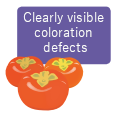 ①Assessment of the impact of global warming on persimmons and mapping of suitable areas for cultivation
①Assessment of the impact of global warming on persimmons and mapping of suitable areas for cultivation
In addition to creating a high temperature damage map for persimmon coloring, other fruit trees were considered as possible alternative products.
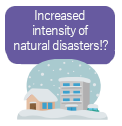 ②Future projections of snow/wind damage risk
②Future projections of snow/wind damage risk
Analyze future natural disaster risks; it has been suggested that the frequency and intensity of heavy rainfall and the frequency of snowfall causing damage will increase.
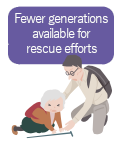 ③Comprehensive assessment of increased frequency of flood/landslide disasters and population decline
③Comprehensive assessment of increased frequency of flood/landslide disasters and population decline
Analyze the impact of typhoons and heavy rains in the future by combining demographic projections with information from flood inundation and flood risk zone maps.
 ④Assessment of impact of global warming on typhoons and heavy rainfall in future climate
④Assessment of impact of global warming on typhoons and heavy rainfall in future climate
Analyze the effects of typhoons and heavy rains using climate and high-resolution weather models that take global warming into account. Consideration of technological support and human resource development to harness these resources.
It is important for everyone to think and act as a stakeholder.
 HARADA : Through Gifu University's "Regional Development Vision 2030," our goal is to realize the vision of Gifu that can quickly adapt to the drastic changes that are occurring, such as climate change and population decline. To achieve this goal, we are scientifically predicting what specific changes will occur from the perspective of each research division, and we are committed to working together with the local community. Currently, we are primarily working with the local government; however, in the future, we would like to work together with local industries to uncover new business opportunities. We would like to create a new image of Gifu that is resilient, yet profitable.
HARADA : Through Gifu University's "Regional Development Vision 2030," our goal is to realize the vision of Gifu that can quickly adapt to the drastic changes that are occurring, such as climate change and population decline. To achieve this goal, we are scientifically predicting what specific changes will occur from the perspective of each research division, and we are committed to working together with the local community. Currently, we are primarily working with the local government; however, in the future, we would like to work together with local industries to uncover new business opportunities. We would like to create a new image of Gifu that is resilient, yet profitable.
Several joint research projects are already underway. With respect to Fuyugaki persimmons, a specialty of Gifu, we are examining whether the area will continue to be suitable for their cultivation in the future. As for the damage caused by snow and strong winds that have been on the rise in recent years, we are assessing which locations are at risk and to what extent based on the analysis of Dr. MURAOKA of the Division of Forest Ecosystem and Resources and Dr. YOSHINO of the Division of Regional Climate Change. Additionally, we are discussing how to maintain local disaster prevention and mitigation systems based on information about past flood damage from small- and medium-sized rivers that has been analyzed by Gifu Prefecture, as well as forecasts of the occurrence of major typhoons and the like. We are also working on the development of a research method to comprehensively evaluate issues that have been evaluated separately in the past, such as the risk of a river flooding and predicting the quality and yield of rice, as well as changes in ecosystems.
The key to these joint research projects is the hands-on information and experience of local government officials. By combining this information with the specialized and scientific knowledge of the university, it will be possible to develop in-depth and more grounded adaptation measures. With the establishment of the Regional Adaptation Research Center, various information on Gifu Prefecture is now available, and this has created a situation where local people can have more realistic discussions.
What all joint research projects have in common is their position on thinking together by all people involved. A typical example of this is our work with ayu fish in the Nagara River. In recent years, the Nagara River has flooded frequently because of climate change. This has greatly affected the growth of ayu fish. Therefore, we are investigating the changes occurring in the Nagara River Basin, developing a model to predict the future, and studying countermeasures. Water temperature measurements, which provide the basic data for these activities, are conducted by actual workers in the fishing industry. The businesses related to cormorant fishing on the Nagara River have a strong sense of crisis after being hit by floods for three consecutive years, and they are working constructively to create a system to generate money even when the cormorant fishing boats are not running.
To confront the issues of climate change and population decline, it is important for every person to be aware that he or she plays a role. Climate change is not merely someone else's problem. We will continue to disseminate information on climate change through our various studies, and I hope that you will take this information and use it as an opportunity to reassess your own lifestyle.
The spread of the new coronavirus is changing the way we live. I believe this is largely because of the imminent danger to life and health. However, climate change and population decline are also notable crises that are creeping up on us, albeit more slowly than the new coronavirus. A few decades are a significantly small timeframe in terms of the history of the entire planet. However, if left unchecked, today's children will undoubtedly face an extremely serious situation. To avoid this, I would like to achieve a "sustainable future for Gifu" by integrating the power of the community, government, and universities.
[ Initiatives for social implementation ]

Publication of "Handbook for a Safe Life @ Gifu - How to Prepare for Increasing Disasters and Decreasing Population"

Utilizes research findings to explain the significant impact of global warming and population decline on the future of the region. The book was published to raise awareness of the need for the entire region to take a proactive role in realizing a disaster-resistant and sustainable future for Gifu. It can be viewed on the web or downloaded as a PDF file.
